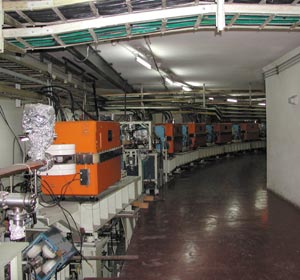
On 10 February, the Chinese government approved the Beijing Electron-Positron Collider Upgrading Program (BEPCII), finally making the long expectation of the Chinese high-energy physics community a reality. When complete in 2006, BEPCII will add a new “factory class” particle collider to the world scene, adding new momentum to research on tau-charm physics. China hopes that the physics potential will attract groups from other countries to join and help the Chinese physicists meet the technical challenge and share the cost of increasing detector performance to ensure first-class results.
The existing Beijing Electron-Positron Collider (BEPC), with a beam energy in the 1-2.5 GeV range, was constructed between 1984 and 1988. The Beijing Spectrometer (BES) is the only detector on this machine, and the research programmes that started in 1989 have concentrated on tau-charm physics. The luminosity of BEPC can reach 1 x 1031 cm-2 s-1 at a beam energy of 1.89 GeV, and over the past 10 years BES has obtained many important experimental results. For example, the precision of the tau mass measurement made in 1992 was 10 times higher than previous measurements, and played an essential role in testing lepton universality. Moreover, since its start-up BES has accumulated about 66 million J/Ψ events and 18 million Ψ′ events – the largest data samples in this energy range.
The main physics aims for the future at BEPC are precision measurements of charm physics and the search for new particles and new phenomena, mainly in the energy region of the J/Ψ and Ψ′. However, this requires both a major upgrade of BEPC to increase its luminosity by two orders of magnitude, and a major upgrade of BES to reduce its systematic errors and to adapt to the high event rates and small bunch spacing in BEPCII.

With the construction of an additional ring, BEPCII will be a double-ring collider that approaches most of the specifications of a particle factory. It will have superconducting micro-beta magnets, a 500 MHz RF system with superconducting cavities and a low impedance vacuum system. The second ring will be accommodated in the existing tunnel of BEPC, with a large horizontal crossing angle of 11 milliradians at the southern interaction region. There will be 93 bunches per ring with a total current of 910 mA per ring. The peak luminosity of BEPCII will be 1033 cm-2 s_1 at a beam energy of 1.89 GeV, which is about 100 times higher than that of BEPC. The upgrade of the linac will provide injection at energies up to 1.89 GeV for “top-up” injection. The positron injection rate will rise from the current 5 mA per minute to 50 mA per minute.
BESII, the current detector at BEPC, will be upgraded to BESIII. Most of the detector components will be rebuilt with up-to-date techniques to include a main drift chamber with small cells, aluminium field wires and helium-based gas; an electromagnetic calorimeter of caesium-iodide crystals of 15 radiation lengths (28 cm); plastic scintillators for time-of-flight; a 1 Tesla superconducting solenoid magnet; and nine layers of RPCs interleaved with the iron plates of the return yoke for muon identification.
Most of the existing utilities at BEPC will be used for BEPCII, after some upgrading. A cryogenics system at 4.2 K will be installed for three types of superconducting devices. The special design of BEPCII will keep the electron beam in the outer ring running during dedicated synchrotron radiation, so there will be no changes to the synchrotron radiation beam lines and the experimental stations, although the beam current will be increased from 140 mA at 2.2 GeV to 250 mA at 2.5 GeV.
The total estimated budget for BEPCII is around 640 million Chinese Yuan (about €70 m). The Chinese government will provide funding to cover the costs of the machine and the major part of the detector, while remaining detector costs are expected to come from international collaboration. There is international co-operation to help the Institute for High Energy Physics (IHEP) in Beijing with the design and R&D of BEPCII, as well as to produce some key devices. For example, the Brookhaven National Laboratory in the US is helping with the superconducting micro-beta magnets, and KEK in Japan is assisting with the superconducting RF cavities and the superconducting solenoid magnet. In May 2002, SLAC hosted a review on the design report of BEPCII, and detailed design is now underway. The construction of BEPCII should begin soon and is expected to finish by the end of 2006, with physics running scheduled for the beginning of 2007.







